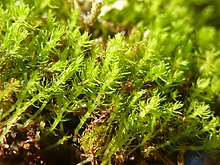195:. It is characterized by its tiny bifid leaves in which each segment is only a few cells wide, conspicuous rhizomous shoots, and long leafless stolon shoots which facilitate the colonization of bare areas. A very unusual feature is the lack of male plants within the species, which are thought to have become extinct during an ice age. Takakia lepidozioides have been found to be a highly adaptive moss. Over the past 65 million years, there have been extreme changes in the climate, however, several molecular adaptations have been observed in this species.
57:
498:
33:
234:
Hu, R., Li, X., Hu, Y., Zhang, R., Lv, Q., Zhang, M., Sheng, X., Zhao, F., Chen, Z., Ding, Y., Yuan, H., Wu, X., Xing, S., Yan, X., Bao, F., Wan, P., Xiao, L., Wang, X., Xiao, W., … He, Y. (2023). Adaptive evolution of the enigmatic
Takakia now facing climate change in Tibet. Cell, 186(17),
366:
405:
167:
444:
340:
379:
384:
539:
410:
305:
332:
251:
171:
256:
56:
397:
532:
449:
513:
371:
327:
267:
558:
151:
423:
314:
8:
563:
436:
525:
470:
51:
418:
475:
509:
431:
290:
552:
236:
462:
392:
353:
299:
186:
44:
497:
32:
345:
358:
261:
457:
284:
191:
128:
118:
108:
98:
88:
319:
68:
505:
78:
205:
212:
Hattori, S.; Inoue, H. (1958). "Preliminary report on
550:
533:
211:
218:Journal of the Hattori Botanical Laboratory
540:
526:
237:https://doi.org/10.1016/j.cell.2023.07.003
31:
551:
266:
265:
492:
43:on a damp slope above Takakia Lake,
13:
14:
575:
245:
496:
55:
228:
189:family, one of two species of
1:
198:
512:. You can help Knowledge by
185:is a species of moss in the
7:
10:
580:
491:
274:
157:
150:
52:Scientific classification
50:
39:
30:
23:
257:Botany Photo of the Day
508:-related article is a
252:Flora of North America
306:Takakia lepidozioides
276:Takakia lepidozioides
214:Takakia lepidozioides
182:Takakia lepidozioides
161:Takakia lepidozioides
143:T. lepidozioides
25:Takakia lepidozioides
41:Takakia lepidoziodes
521:
520:
486:
485:
419:Open Tree of Life
268:Taxon identifiers
178:
177:
571:
542:
535:
528:
500:
493:
479:
478:
466:
465:
453:
452:
440:
439:
427:
426:
414:
413:
401:
400:
388:
387:
375:
374:
362:
361:
349:
348:
336:
335:
323:
322:
310:
309:
308:
295:
294:
293:
263:
262:
239:
232:
226:
225:
209:
163:
60:
59:
35:
21:
20:
579:
578:
574:
573:
572:
570:
569:
568:
549:
548:
547:
546:
489:
487:
482:
474:
469:
461:
456:
448:
443:
435:
430:
422:
417:
409:
404:
396:
391:
383:
378:
370:
365:
357:
352:
344:
339:
331:
326:
318:
313:
304:
303:
298:
289:
288:
283:
270:
248:
243:
242:
235:3558-3576.e17.
233:
229:
210:
206:
201:
174:
165:
159:
146:
54:
17:
16:Species of moss
12:
11:
5:
577:
567:
566:
561:
545:
544:
537:
530:
522:
519:
518:
501:
484:
483:
481:
480:
476:wfo-0001195979
467:
454:
441:
428:
415:
402:
389:
376:
363:
350:
337:
324:
311:
296:
280:
278:
272:
271:
260:
259:
254:
247:
246:External links
244:
241:
240:
227:
203:
202:
200:
197:
176:
175:
166:
155:
154:
148:
147:
140:
138:
134:
133:
126:
122:
121:
116:
112:
111:
106:
102:
101:
96:
92:
91:
89:Takakiophytina
86:
82:
81:
76:
72:
71:
66:
62:
61:
48:
47:
37:
36:
28:
27:
15:
9:
6:
4:
3:
2:
576:
565:
562:
560:
557:
556:
554:
543:
538:
536:
531:
529:
524:
523:
517:
515:
511:
507:
502:
499:
495:
494:
490:
477:
472:
468:
464:
459:
455:
451:
446:
442:
438:
433:
429:
425:
420:
416:
412:
407:
403:
399:
394:
390:
386:
381:
377:
373:
368:
364:
360:
355:
351:
347:
342:
338:
334:
329:
325:
321:
316:
312:
307:
301:
297:
292:
286:
282:
281:
279:
277:
273:
269:
264:
258:
255:
253:
250:
249:
238:
231:
223:
219:
215:
208:
204:
196:
194:
193:
188:
184:
183:
173:
169:
164:
162:
156:
153:
152:Binomial name
149:
145:
144:
139:
136:
135:
132:
131:
127:
124:
123:
120:
117:
114:
113:
110:
107:
104:
103:
100:
97:
94:
93:
90:
87:
85:Subdivision:
84:
83:
80:
77:
74:
73:
70:
67:
64:
63:
58:
53:
49:
46:
42:
38:
34:
29:
26:
22:
19:
559:Takakiopsida
514:expanding it
503:
488:
437:tro-35184411
275:
230:
221:
217:
213:
207:
190:
181:
180:
179:
160:
158:
142:
141:
129:
99:Takakiopsida
40:
24:
18:
393:NatureServe
354:iNaturalist
300:Wikispecies
187:Takakiaceae
119:Takakiaceae
45:Haida Gwaii
564:Moss stubs
553:Categories
432:Plant List
224:: 133–137.
199:References
109:Takakiales
75:Division:
333:200000002
137:Species:
79:Bryophyta
65:Kingdom:
463:35184411
458:Tropicos
398:2.124527
372:10348735
291:Q7677100
285:Wikidata
168:S. Hatt.
115:Family:
346:5710306
192:Takakia
130:Takakia
125:Genus:
105:Order:
95:Class:
69:Plantae
445:PLANTS
359:155949
320:420551
170:&
504:This
450:TALE3
424:79112
411:37425
385:14205
367:IRMNG
172:Inoue
510:stub
506:moss
406:NCBI
380:ITIS
341:GBIF
471:WFO
328:FNA
315:EoL
216:".
555::
473::
460::
447::
434::
421::
408::
395::
382::
369::
356::
343::
330::
317::
302::
287::
222:19
220:.
541:e
534:t
527:v
516:.
Text is available under the Creative Commons Attribution-ShareAlike License. Additional terms may apply.
